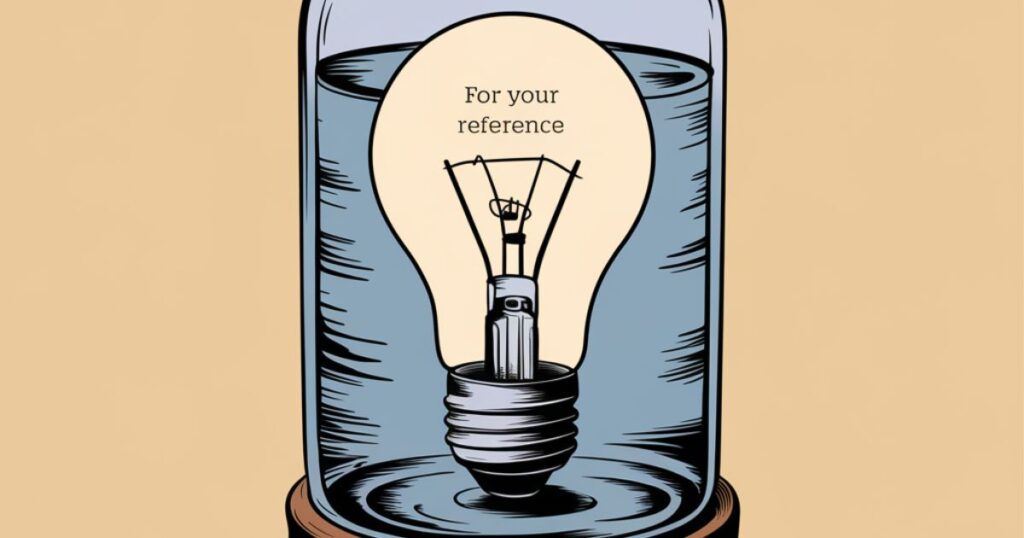Ever feel like you’re stuck in a linguistic rut, rehashing the same tired phrases in your work emails? You’re not alone. In the fast-paced world of professional communication, it’s easy to fall back on familiar expressions. But what if I told you there’s a whole universe of alternatives to the ubiquitous “for your reference”? Buckle up, because we’re about to embark on a journey through 20 fresh ways to convey that vital information to your colleagues, clients, and partners. 20 Ways To Say “For Your Reference”.
Alternative Ways of Saying “For Your Reference”

1. Perusal Purposes
When you want to strike a balance between formal and approachable, “for your perusal” is a gem. It implies a thorough examination without the stuffy overtones of more traditional phrases.
“I’ve attached the quarterly report for your perusal. Take your time with it – there’s a lot to unpack!”
This phrase works wonders when you’re sending along detailed documents that require more than a cursory glance. It’s especially useful in legal or financial contexts where attention to detail is paramount.
2. Consult the Following
“Consult the following” adds a touch of authority to your message. It suggests that the information you’re providing is a valuable resource, worthy of careful consideration.
When to use it:
- Sharing industry guidelines
- Providing step-by-step instructions
- Referencing important data sets
This phrase shines when you’re positioning yourself as a subject matter expert. It subtly reinforces your credibility while inviting the reader to engage with the material.
3. Reference the Attached
Clarity is king in professional communication, and “reference the attached” leaves no room for ambiguity. It’s a straightforward way to direct attention to specific documents or files you’ve included with your message.
Best practices for attachments:
- Use clear, descriptive file names
- Mention the attachment in the body of your message
- Double-check that you’ve attached the file before hitting send
Pro tip: Pair this phrase with a brief description of the attachment’s contents to give your reader context before they open it.
4. Review at Your Convenience
In our always-on work culture, acknowledging someone’s time constraints can go a long way. “Review at your convenience” does just that, striking a balance between providing information and respecting the recipient’s schedule.
This phrase is particularly useful when:
- Sharing non-urgent updates
- Providing background information for future reference
- Following up on previous conversations
Remember, though, if something is truly time-sensitive, be clear about deadlines to avoid misunderstandings.
5. Examine the Enclosed
There’s something delightfully old-school about “examine the enclosed.” It harkens back to the days of physical memos while still feeling relevant in our digital age. This phrase works equally well for email attachments or good old-fashioned paper documents.
Adding a touch of formality:
- Perfect for correspondence with senior executives
- Useful in academic or research settings
- Adds gravitas to important financial or legal documents
6. Investigate the Following
Want to pique your reader’s curiosity? “Investigate the following” turns a simple information share into an invitation for exploration. It’s particularly effective when you’re presenting new ideas or complex concepts that require active engagement.
Case study: A tech startup used this phrase when introducing a new product feature to beta testers. The result? Higher engagement rates and more detailed feedback compared to their usual “for your reference” emails.
7. Delve Into the Details
When you’re dealing with complex topics or in-depth analyses, “delve into the details” is your go-to phrase. It signals to the reader that the information you’re sharing is comprehensive and worthy of their full attention.
This phrase is particularly useful in:
- Research and development updates
- Complex project proposals
- Detailed market analyses
Pair it with a high-level summary to give your readers a roadmap before they dive in.
8. Explore the Document
“Explore the document” strikes a balance between professional and inviting. It suggests that the information you’re sharing is worth discovering, without the heavy-handed implication that it’s required reading.
Making it inviting:
- Use an engaging subject line
- Provide a brief teaser of the document’s contents
- Highlight key sections or takeaways
This approach works well for lengthy reports or strategy documents where you want to encourage thorough reading without overwhelming your audience.
9. Absorb the Information
Sometimes, you need your message to stick. “Absorb the information” implies importance without being pushy. It’s a softer approach that can be particularly effective when you’re sharing critical updates or new policies.
“Please absorb the information in the attached safety guidelines. Your understanding is crucial for our upcoming site visit.”
This phrase works well in situations where retention of information is key, such as training materials or important procedural changes.
10. Scrutinize the Details
In fields where precision is paramount, “scrutinize the details” sends a clear message about the level of attention you expect. This phrase is particularly useful in legal, financial, or engineering contexts where even small errors can have significant consequences.
Industries where scrutiny is crucial:
- Legal (contract review)
- Finance (audit reports)
- Engineering (technical specifications)
- Healthcare (medical protocols)
When using this phrase, be prepared for questions or requests for clarification. It invites a level of engagement that may lead to valuable discussions and improvements.
11. Refer to the Following
A classic alternative with a modern twist, “refer to the following” is versatile enough for almost any professional context. It’s direct without being bossy, guiding your reader’s attention without demanding it.
Tips for making it fresh:
- Pair it with a specific action item
- Use it to introduce bulleted lists or key points
- Follow it with a question to encourage engagement
12. Analyze the Enclosed Information
When you’re dealing with data-heavy communications, “analyze the enclosed information” is your best friend. It encourages critical thinking and signals that the information you’re sharing is substantial and worthy of careful consideration.
This phrase is particularly effective in:
- Financial reports
- Market research findings
- Scientific study results
Consider including a summary of key findings to guide your reader’s analysis.
13. Inspect the Attached
In a world of information overload, sometimes brevity is key. “Inspect the attached” gets straight to the point, perfect for busy professionals who appreciate directness.
When to use it:
- Quick updates or status reports
- Routine document sharing
- Follow-ups to previous discussions
While concise, be careful not to come across as curt. A friendly opening or closing can soften the tone when needed.
14. Consider the Following
“Consider the following” opens up dialogue and encourages feedback. It’s an excellent choice when you’re presenting options or seeking input on ideas or proposals. 20 Ways To Say “For Your Reference”.
This phrase works well in:
- Decision-making processes
- Brainstorming sessions
- Collaborative project planning
Follow it up with clear points or questions to guide the consideration process and facilitate productive discussions.
15. Perceive the Information Below
Adding a touch of sophistication to your communication, “perceive the information below” is particularly well-suited to academic or research settings. It suggests a deeper level of understanding beyond mere reading. 20 Ways To Say “For Your Reference”.
Use cases:
- Sharing complex research findings
- Presenting theoretical concepts
- Introducing new methodologies
Be cautious not to overuse this phrase in more casual business settings, as it can come across as pretentious if used out of context.
16. Navigate the Document
When you’re sharing complex or lengthy materials, “navigate the document” provides a sense of guidance to your readers. It’s like offering a map before sending someone on a journey through your information. 20 Ways To Say “For Your Reference”.
Making large documents less daunting:
- Include a table of contents
- Use clear headings and subheadings
- Provide a brief overview or executive summary
This approach is particularly useful for comprehensive reports, user manuals, or extensive policy documents. 20 Ways To Say “For Your Reference”.
17. Survey the Contents
Sometimes, you need your readers to get a broad overview rather than dive deep. “Survey the contents” encourages a high-level review, perfect for situations where skimming is appropriate or when you’re providing background information.
“Please survey the contents of the attached market report. We’ll discuss the key findings in our strategy meeting next week.”
This phrase is useful when you want to provide context without requiring an in-depth analysis right away.
18. Examine the Provided Information
Striking a balance between formal and approachable, “examine the provided information” is perfect for official communications. It’s particularly well-suited for government or corporate settings where a certain level of formality is expected. 20 Ways To Say “For Your Reference”.
Tone considerations:
- Use in formal reports or official correspondence
- Pair with clear, concise language
- Follow up with specific action items or next steps
This phrase conveys the importance of the information without sounding overly bureaucratic.
19. Investigate the Attached Materials
When you’re dealing with multiple documents or complex information sets, “investigate the attached materials” implies depth without overwhelming your reader. It’s particularly useful in project management contexts where you’re sharing various resources. 20 Ways To Say “For Your Reference”.
Project management application:
- Kickoff materials for new initiatives
- Comprehensive project updates
- Resource collections for team reference
Consider providing a brief guide or summary to help your team navigate multiple attachments effectively.
20. For Your Consideration
Last but not least, “for your consideration” offers a polite, open-ended alternative that invites input while providing information. It’s an excellent choice when you want to share information and get feedback or decisions based on that information.
When to use it:
- Proposing new ideas or strategies
- Sharing options for decision-making
- Presenting work for review or approval
This phrase opens the door for dialogue, making it a valuable tool in collaborative work environments. 20 Ways To Say “For Your Reference”.
Conclusion
As we’ve explored these 20 alternatives “for your reference,” it’s clear that the language we use in professional communication can significantly impact how our messages are received and acted upon. By varying your phrases, you not only keep your writing fresh and engaging but also tailor your tone to specific situations and audiences.
FAQs
What can I say instead of “for your reference”?
Here’s a quick list of the top 5 alternatives:
- For your consideration
- Please review
- Kindly note
- For your perusal
- Please examine
The key is to choose a phrase that fits the tone and urgency of your message. Consider your relationship with the recipient and the nature of the information you’re sharing when selecting an alternative.
How do you say “for your reference” politely?
Politeness in professional communication often comes down to acknowledging the recipient’s time and autonomy. Here are some polite alternatives:
- “When you have a moment, please review…”
- “I’d appreciate your thoughts on the attached…”
- “At your convenience, please take a look at…”
The key is to balance directness with respect for the recipient’s schedule and workload.
What word can I use instead of reference?
Depending on your context, consider these alternatives:
- Information
- Resource
- Guide
- Document
- Material
For example, “For your information” or “Please consult this resource” can change the tone of your message while conveying a similar meaning to “for your reference.”
What are some reference words?
When discussing references in professional settings, you might encounter or use words like:
- Cite
- Consult
- Allude
- Mention
- Refer
- Source
- Attribute
Incorporating these into your professional vocabulary can add precision and variety to your communication. For instance, instead of “Please reference the report,” you might say “Please consult the report for detailed figures” or “The strategy alludes to concepts discussed in our previous meeting.”











